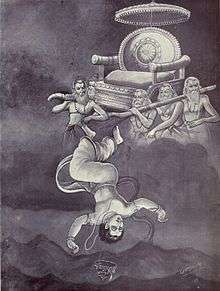Nahusha
| Nahusha | |
|---|---|
 Nahusha falls from heaven |
Nahusha (Sanskrit: नहुष) was a well-known king of the Aila dynasty. He was the son of Ayu, the eldest son of Pururavas and Prabha, the daughter of Svarbhanu. Nahusha reigned from Pratishthana. He married Viraja, the daughter of the Pitrs. They had six or seven sons, according to different Puranas. His eldest son Yati became a muni (ascetic). He was succeeded by his second son Yayati.[1] In another variation of his story, he is said to have married Ashokasundari, a regional goddess who is said to be daughter of Shiva and Parvati and is said to have given birth to Yayati and a hundred daughters of Nahusha.[2][3]
This king is mentioned by Manu as having come into conflict with the Brahmins, and his story is repeated several times with variations in different parts of the Mahabharata as well as in the Puranas. According to Manu "By sacrifices, austere fervour, sacred study, self-restraint, and valour, Nahusha acquired the undisturbed sovereignty of the three worlds. Through want of virtuous humility the great king Nahusha was utterly ruined".
One version of the narrative says that he aspired to the possession of Indrani, wife of Indra, when that god had concealed himself for having killed a Brahmin. A thousand great Rishis bore the palanquin of Nahusha, and on one occasion he touched with his foot the great Agastya, who was carrying him. The sage in his anger cried out, "Fall, thou serpent," and Nahusha fell from his glorious car and became a serpent.
Agastya, at the supplication of Nahusha, put a limit to the curse; and according to one version, the doomed man was released from it by the instrumentality of Yudhishthira, when he threw off "his huge reptile form, became clothed in a celestial body, and ascended to heaven."
Sister Nivedita also has mentioned about the king Nahusa in one story "The Worth of Kine" in relation to the great sage Bharadwaja who was accidentally caught in a net along with fish by fishermen who were fishing in a river. The fishermen took the rishi Chyavana to king Nahusha and asked him to pay the price for the fish and the rishi, with the king offering a cow in return for the sage.[4]
Nahusha became an Indra
The enraged Agastya retaliated by a curse "sarpo bhava"(become a snake). The King Nahusha turned into a snake fell down to Earth. Sage Narada intervened on his behalf and Agastya relented and said that Yudhishthira would be instrumental in Nahusha's release from the curse.[5]
References
- ↑ Pargiter, F.E. (1972). Ancient Indian Historical Tradition, Delhi: Motilal Banarsidass, p.85-6.
- ↑ George M. Williams (27 March 2008). Handbook of Hindu Mythology. Oxford University Press. pp. 217–8, 230. ISBN 978-0-19-533261-2.
- ↑ Gaṅgā Rām Garg (1992). Encyclopaedia of the Hindu World Vol. 3. Concept Publishing Company. p. 712. ISBN 978-81-7022-376-4.
- ↑ Margaret Elizabeth Noble; Ananda Kentish Coomaraswamy; Sister Nivedita. Myths of the Hindus and Buddhists. pp. 371–372. ISBN 978-0-48-621759-8.
- ↑ John Dowson. A Classical Dictionary of Hindu Mythology, and Religion, Geography, History, and Literature. pp. 213–214. ISBN 978-81-206178-65.
